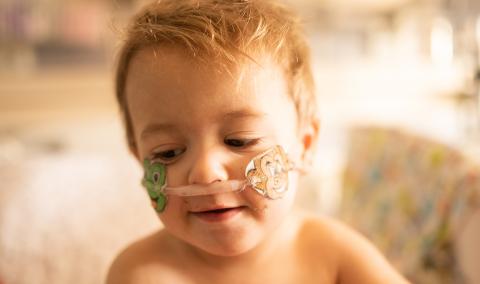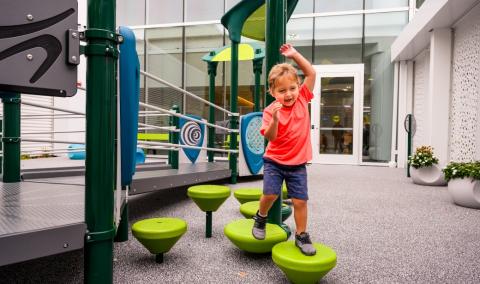Children with Pierre Robin sequence are born with a smaller jaw than usual. Because the lower jaw is positioned farther back and is smaller, it causes the tongue to block the airway and esophagus, leading to breathing and feeding difficulties for your baby.
At University of Missouri Children’s Hospital, we understand this can be a frightening diagnosis for families, and our specialists are here to help. The Children's Health team at MU Health Care works closely with your child and family to develop a customized treatment plan specifically for your child’s needs. If your child’s deformity is mild and breathing can be managed with prone positioning, no surgery is required. However, if the deformity is severe and breathing is a problem, surgical treatment is necessary.
Your surgeon will sit down with you and very carefully explain everything that is being done as well as the reasons behind each test and procedure. You will be able to ask questions and have everything explained thoroughly to you.
After surgical treatment, most babies do well and have no further problems. Babies with a cleft palate will require another surgery to repair the palate. Your surgeon follows your child over the long term to carefully assess his or her growth and development.
Frequently asked questions about Pierre Robin sequence
Get answers to commonly asked questions about this condition.
Is this condition painful?
No, this condition does not cause your baby pain, but some babies may have severe breathing difficulty.
Are there different types of Pierre Robin sequence?
Yes, there is a spectrum of severity with this condition.
Who gets Pierre Robin sequence?
Any baby can be born with Pierre Robin sequence, and, in some cases, it may be inherited. About half of babies also have a cleft palate.
What causes this condition?
It is thought that an abnormal position of the baby in the womb, with pressure on the developing lower jaw, may cause this condition. In addition, there may be genetic influences involved.
What are the main issues related to Pierre Robin sequence?
Babies with Pierre Robin sequence have problems with breathing and feeding, both due to the small lower jaw. In most babies, the breathing problems can be managed with prone positioning, meaning keeping your baby face down so that the tongue does not fall back and block the airway. However, when the jaw is extremely small and breathing is very difficult, your child may not be able to feed adequately and may expend all of his or her energy trying to breathe. In these cases, surgery is required to prevent failure to thrive or even death. In some cases, babies with Pierre Robin Sequence may have problems with gastroesophageal reflux and/or swallowing difficulties. Occasionally, a feeding tube may be temporarily required.
What is the treatment for children with this condition?
Traditionally, a tracheostomy will be done. This is an operation that creates an opening into the windpipe in the neck that bypasses the obstruction of the airway at the level of the tongue. When your child is older and the jaw has grown forward, the tracheostomy tube can be removed. However, there are two other surgical options that might be appropriate in some cases and eliminate the need for a tracheostomy:
- Tongue-lip adhesion. This is a temporary attachment of the tongue to the lower lip; this pulls the tongue forward and can relieve the airway obstruction.
- Distraction osteogenesis. The most recent surgical advancement for children with Pierre Robin sequence is a technique by which the lower jaw can be gradually moved forward over several days’ time, using a device that is surgically attached to the jaw. As the jaw moves forward, the tongue also moves forward and the airway obstruction is relieved.
These treatments are done very early in life, sometimes within the first week.
What happens after my baby is born with Pierre Robin sequence?
Our team will initially observe your baby in the Neonatal Intensive Care Unit (NICU). If your baby is able to breathe and feed adequately, our specialists will instruct you on prone (belly) positioning and feeding techniques. When your baby is doing well, he or she will go home with you.
If your baby is having difficulty with breathing and feeding, he or she will stay in the NICU. We may place a breathing tube so that a ventilator can assist in breathing. This is usually temporary until our team determines the appropriate surgical treatment for your child.
What specialists will be involved in my child’s care?
The optimal treatment of children with Pierre Robin sequence is achieved in a multidisciplinary setting. Usually, the specialists involved include a:
- Neonatologist
- Craniofacial surgeon (a plastic surgeon who has done additional specialized training)
- Otolaryngologist (ENT doctor)
- Pediatric anesthesiologist
- Developmental pediatrician
- Geneticist
- Pediatric plastic surgery nurse
Related Conditions & Treatments
- Adolescent Medicine
- Chest Wall Deformities
- Down Syndrome
- Emergency Care for Kids
- Gastrostomy and Feeding Access Program
- Hyperbaric Oxygen Therapy
- Juvenile Diabetes
- Neonatology
- Pediatric Anesthesiology
- Pediatric Cancer
- Pectus Carinatum
- Pectus Excavatum
- Pediatric Cardiology
- Pediatric Dermatology
- Pediatric Development and Behavior
- Pediatric ENT (Ear, Nose and Throat)
- Pediatric Epilepsy
- Pediatric Eye Care
- Pediatric Gastroenterology
- Pediatric Infectious Diseases
- Pediatric Inpatient Rehabilitation
- Pediatric Nephrology
- Pediatric Neurology
- Pediatric Neurosurgery
- Pediatric Orthopaedics
- Pediatric Plastic Surgery
- Pediatric Primary Care
- Pediatric Psychiatry
- Pediatric Pulmonary Medicine
- Pediatric Sleep Medicine
- Pediatric Surgery
- Pediatric Surgical Services
- Pediatric Urology
- Pediatric Vascular Anomalies
- Pediatric Weight Management
- Sickle Cell Disease
- Aerodigestive Program



























